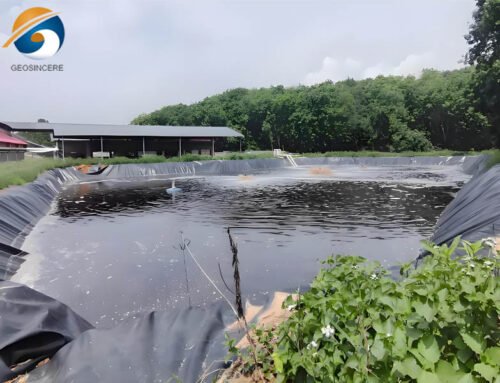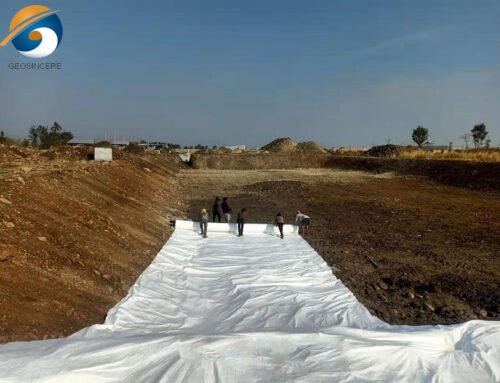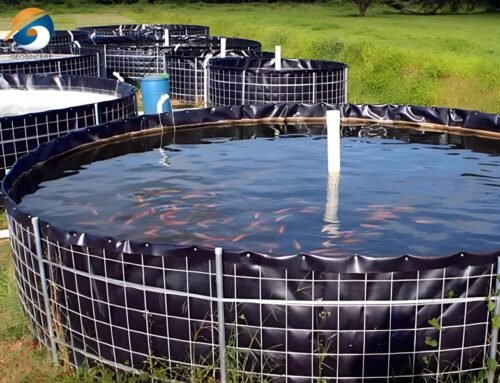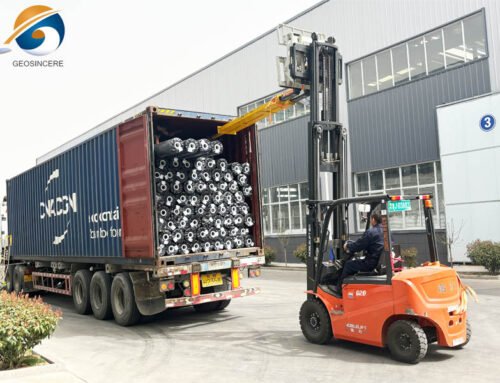High Density Polyethylene Pond Liner is a type of geomembrane liner specifically designed for lining ponds, lakes, reservoirs, and other water containment applications. It is made from high-density polyethylene, a strong and durable plastic material known for its excellent chemical resistance, UV resistance, and impermeability.
As the leading geosynthetics manufacturer and supplier, GEOSINCERE offer various types High Density Polyethylene Pond Liner with custom thickness and size at best factory price.
1. What Are Characteristics Of High Density Polyethylene Pond Liner?
High Density Polyethylene (HDPE) Pond Liner is a versatile and durable material used in various applications, including the construction of ponds and water bodies. Here are some of its characteristics:
1.1 Chemical Resistance
HDPE is highly resistant to chemicals, making it suitable for use in environments where there may be exposure to harsh or corrosive substances.
1.2 UV Stability
It has excellent resistance to ultraviolet light, which helps maintain its strength and integrity over time when exposed to sunlight.
1.3 Puncture Resistance
HDPE liners are puncture-resistant, reducing the risk of damage from sharp objects or debris that may come into contact with the liner.
1.4 Flexibility
The material is flexible, allowing it to conform to irregular shapes and adapt to changes in the pond’s structure due to settling or other factors.
1.5 Temperature Tolerance
HDPE can withstand a wide range of temperatures without losing its properties, ensuring performance in both hot and cold climates.
1.6 Tear Strength
The liner exhibits good tear strength, meaning it can resist tearing even under stress or impact.
1.7 Installation Friendly
HDPE liners are relatively easy to install compared to other materials, often requiring less equipment and labor.
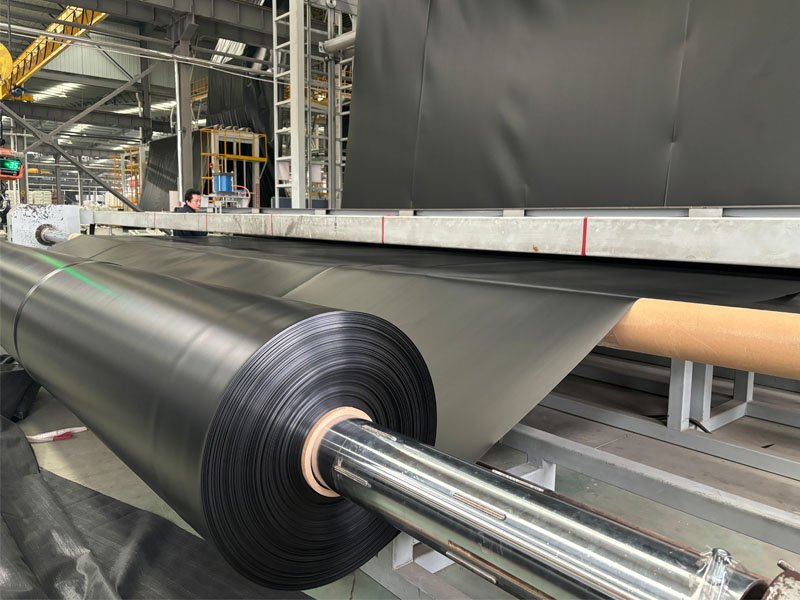

2. What Is Application Of High Density Polyethylene Pond Liner?
High Density Polyethylene (HDPE) pond liners are widely used in various water containment applications due to their excellent impermeability and durability. Some common applications of HDPE pond liners include:
2.1 Ponds and Lakes
HDPE pond liners are extensively used for lining decorative ponds, fish ponds, and natural or artificial lakes. They create a reliable barrier that prevents water seepage and ensures water retention.
2.2 Reservoirs and Water Storage
HDPE pond liners are employed in the construction of reservoirs and water storage systems. They effectively contain large volumes of water, ensuring its availability for various purposes such as irrigation, drinking water supply, and industrial processes.
2.3 Aquaculture
HDPE pond liners play a crucial role in aquaculture operations, including fish farming and shrimp cultivation. They provide a secure and impermeable lining that prevents water loss and protects the aquatic environment.
2.4 Landfill Liners
HDPE pond liners are used as liners in landfills to prevent the leakage of contaminated liquids into the soil and groundwater. They serve as a barrier that helps protect the environment from hazardous substances.
2.5 Mining Applications
HDPE pond liners are utilized in mining applications, such as tailings ponds and heap leach pads. They prevent the seepage of mining by-products and chemicals into the surrounding environment, minimizing the impact on local ecosystems.
2.6 Industrial Ponds and Wastewater Treatment
HDPE pond liners are employed in industrial ponds, such as settling ponds and wastewater treatment ponds. They ensure containment of industrial effluents, preventing their release into the environment.
3. How To Choose Right High Density Polyethylene Pond Liner?
Choosing the right High Density Polyethylene (HDPE) pond liner involves considering several factors to ensure it meets the specific requirements of your project. Here are some key considerations to keep in mind when selecting an HDPE pond liner:
3.1 Determine Size and Shape
Before selecting an HDPE pond liner, it is important to know the dimensions and shape of your pond. This will help you choose a liner that fits perfectly and covers all the necessary areas.
3.2 Consider Thickness
The thickness of the HDPE pond liner is crucial as it determines its durability and strength. A thicker liner will be more resistant to punctures, tears, and other forms of damage.
3.3 UV Resistance
Exposure to sunlight can cause UV degradation, which can weaken the material over time. Choose an HDPE pond liner that has been treated with UV stabilizers to ensure longevity and performance.
3.4 Chemical Resistance
If you plan to use chemicals in your pond, such as herbicides or algae control products, make sure the HDPE pond liner is resistant to these substances. This will prevent any adverse reactions or damage to the liner.
3.5 Warranty and Installation
Consider the warranty offered by the manufacturer and the installation process required for the HDPE pond liner. A longer warranty and easier installation process can save you time and money in the long run.


4. How To Install High Density Polyethylene Pond Liner?
Installing a High Density Polyethylene (HDPE) pond liner requires careful planning and attention to detail. Here is a general guide on how to install an HDPE pond liner:
- Prepare the site: Ensure the area where the HDPE liner will be installed is clean and free of sharp objects that could puncture the liner. Remove any rocks, roots, or debris that might damage the material.
- Lay out the liner: Unroll the HDPE liner on the prepared surface, taking care not to drag it across rough terrain or sharp edges. Position it according to your pond design, allowing enough overhang around the edges for anchoring and adjustments.
- Cut the liner to size: Use a sharp knife or blade specifically designed for cutting plastics to trim the liner to fit the exact dimensions of your pond. Leave an adequate margin for overlapping and folding under the edges.
- Secure the edges: Anchor the edges of the liner with soil, rocks, or other weights to keep it in place as you work. This step prevents the liner from shifting during installation.
- Attach the liner: Depending on your pond design, you may need to attach the liner to walls or other structures using appropriate fasteners like clamps or sealant. Ensure all connections are watertight to prevent leaks.
- Fill the pond: Slowly fill the pond with water, monitoring for any leaks or issues with the liner. Adjust as necessary to ensure a proper fit and seal.
- Finish the edges: Once the pond is filled, fold the excess liner over the edge and cover with soil or landscaping materials to create a natural look and further secure the liner in place.
- Maintain the pond: Regularly check the HDPE liner for wear and tear and perform maintenance as needed to prolong its lifespan and maintain water quality.
5. Conclusion
In conclusion, choosing the right high-density polyethylene (HDPE) pond liner is crucial for ensuring the longevity and effectiveness of your water body. By considering factors such as thickness, durability, UV resistance, and installation ease, you can select a liner that meets your specific needs and budget. Remember to consult with a professional installer and follow proper maintenance guidelines to maximize the lifespan of your HDPE pond liner.
If you have any questions, please feel free to contact us.

